News from Picacho Lodge
September 6th 2012
Ryan’s email from Picacho
Hi Austin,
I just wanted to tell you about the fantastic time my father and I had down at Picacho Lodge. What an absolutely incredible place! The scenery was so beautiful I could hardly take my eyes off the views the entire time down there. It really does feel like you are in a different world. The guides and lodge staff couldn’t have been better and the food and accommodations were all first class. The remote location offered the unique ability to getaway from our busy lives back home and provide an incredibly refreshing vacation.
The diversity of the fishing opportunities made us feel like each day we were starting a new adventure. Whether it was making that first cast at the waterfall pool on the lower Picacho, hiking up the mountain to Lake Roosevelt, or even speeding through the narrow outlet of the lagunas, the anticipation of how each day would play out felt like Christmas morning everyday! My fondest memory is our day of epic fishing in the lagunas. That was some of the best fishing I have ever experienced in my life. Not to mention the unique environment that it took place in or having the opportunity to share it with my father.
What really stands out to me about Picacho lodge is the people. Their enthusiasm and commitment to the guests was genuine and exceeded all our expectations. I can’t emphasize that enough. The worst part about the trip was saying goodbye to our new friends in Patagonia. Hopefully, we will get to say hello again soon. I have never been on fly-fishing adventure trip like this before but I can tell you now, I am “hooked”. You guys do it right, great Job!
Thanks again,
Ryan Williams
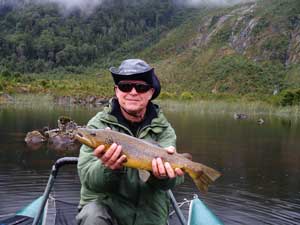 |
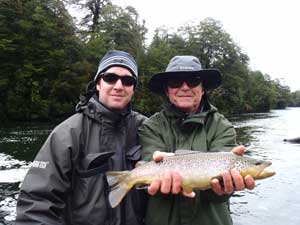 |
| Ryan and his Dad enjoying the fishing at Picaho Lodge | |
PICACHO LODGE
To help you plan your trip, Picaho Lodge manager Cristian Effa has this inside scoop on fishing conditions at their locale -
LOCATION:
Picacho Lodge is located in the Aysen Region of Chile 130 kilometers to the northeast of the city of Coyhaique in the Chilean Patagonia. To get to the Lodge you ride from the airport in Balmaceda for approximately 2 hours to the Picacho River. Then you descend on the Picacho for about 30 minutes on a Jet powered NRS cataraft to the Lodge.
The access to the Lodge is by the river and it cannot be reached by road and even by horseback is extremely difficult except for the most experienced.
The use of jet motors is required to bypass obstacles and low points in the river. Because of this difficult access the valley where the Lodge is located is maintained as one of the most pristine and untouched in the entire Patagonia. There are no other residents in the valley and Access from the Pacific side is blocked by a deep and nearly impassable canyon. Some of the tres in the área are over a thousand years old and while in the valley these trees and the native wildlife will be the only observers that the angler will have as he casts in the gin clear waters. This is the reason that explaines the excellent level of fishing that these waters have.
The LODGE:
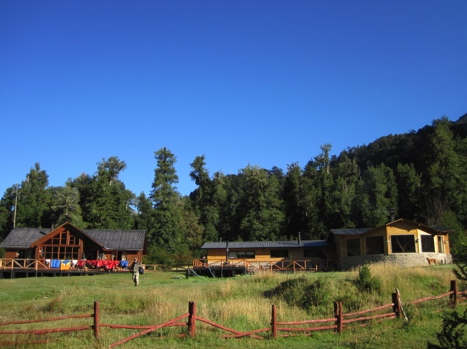
The beautiful Lodge is constructed with native wood from the área and is located on the banks of the river Picacho. The Lodge has a capacity for 6 guests and has everything needed to enjoy to the maximum a fishing adventure in the Patagonia. In addition we are completing a semi-permanent camp/lodge at the juncture of the Picaflor and Toqui rivers outside of the valley which will have all the aspects of the lodge including beds, showers, etc. This will provide easier access to the fishing areas in the Manihuales watershed.
FISHING PLACES:
The Lodge has a great number and different types of waters to fish almost too numerous to mention. This includes small lakes, a few spring creeks, large lakes, rivers of all different sizes all of which are fished depending on the temperatures and climate factors of the moment. The areas where we fish are divided between two watersheds which are completely separated.
The Picacho watershed is composed of the Picacho River, Cobarde River, Rio Roosevelt, Lake Roosevelt, and Lake Copa. It is isolated from downstream access from the Pacific at the end of Lake Copa by a nearly impassable canyon which in 10 miles or so reached the small fishing village of Puerto Cisnes.
The Manihuales watershed starts with the River Toqui and Lake PAC and combines with the River Picaflor to “officially” form the Manihuales. This is the point where these 2 rivers meet that we have a base camp on the banks of the river. We are going through a major upgrade there with permanent Dome living areas, bathrooms, kitchen, etc to make it a 3 season lodge/camp. The Manihuales then continues almost120 miles or so to the Pacific at Puerto Aysen.
Rio Manihuales Watershed :
River Toqui (War Chief):
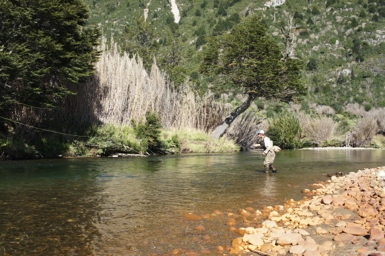 |
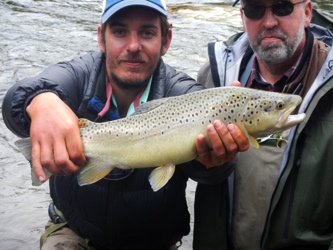 |
The Toqui is a medium sized river located outside of the Picacho valley and the base of the river is largely round stones. The Toqui has a large quantity of structures, large boulders, and submerged trunks. When the water level is low you can see the entire river. The fishing is done 90% with floating line and terrestrials imitating beetles and is largely Brown Trout in the rangeof 1-5 pounds.
River Mañihuales: (forest with wild cows)
The Manihuales is a large and long river river located outside of the Picacho Valley. The base of the river is stones with a great quantity of submerged trunks on the sides. The fishing is typically done floating in catarafts casting towards the sides of the river. We use both floating and sinking lines and the Trout vary between 1-6 pounds and in some rare cases trophy sizes up to 9 pounds
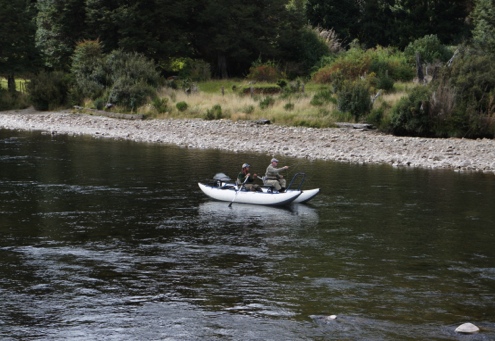 |
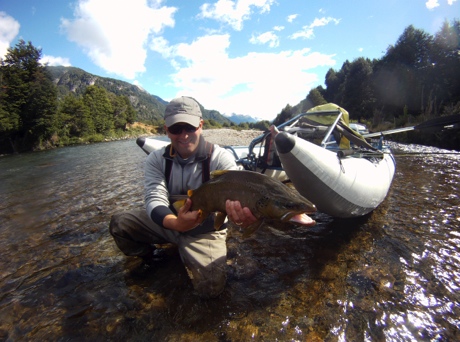 |
Lake Pedro Aguirre Cerda (PAC) (Presdient of Chile)
Lake PAC is of medium size and a great part of its shores are covered by vegetation and it is filled with many reed beds. This permits in sunny days excellent fishing with dragonfly type flies both adult and ninfa and in overcast days the fishing is based in medium size flies mostly streamers.
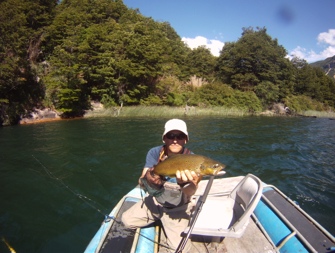 |
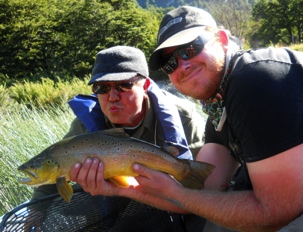 |
Lake Las Torres (The Towers):
Lake Torres is a large lake and like Lake PAC it has very large areas covered by reeds. The flies most used are streamers and the trout are between 1.5 – 6 pounds. We have boats and motors kept on the lake from where we do most of the fishing
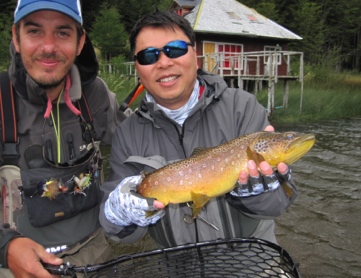
Rio Picacho Watershed
River Picacho (Sharp Point)
The river is divided into 3 sections
Picacho High Section:
The high section of the Picacho is located between the cataraft embarkation and the lodge and is a section of about 8 miles with waters that are relatively low in most cases. The fishing is done drifting in the catarafts and depending on the temperature with floating or sinking lines, The trout in this part of the river are smaller than further down but the quantity can be very good, In the months of March in this part of the river there are large King Salmon which can be fished with flies imitating eggs. The fishing can be very exciting with lighter tackle and there is a nix of Browns and Rainbows.
Picacho Central Section
The central section is between the Lodge and the Falls coming out of Lake Roosevelt. In this area we use in most cases sinking lines with medium streamers with the size of the fish in the small to medium range and both browns and rainbows
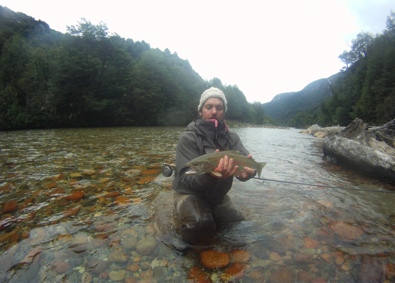 |
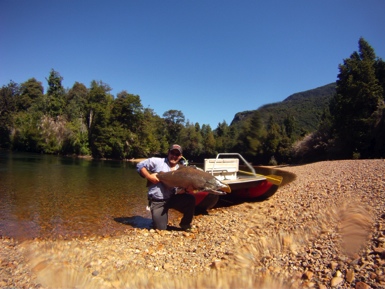 |
Picacho Lower Section
This is the widest part of the river with approximately double the flow of the upper sections with very good fishing in sunny days with imitations of odonatos near the entrance of the river into Lake Copa and in cloudy days the fishing centers in using streamers with rubber legs which are launched in the direction of the shore around the vegetation that mixes with the river. The trout in this part of the river are an average of about 2 pounds and both brown and rainbow.
Lake Copa (Cup):
This is a very large lake formed by glacier activity and the shores are in some places very steep rock with vegetation. The fishing here is done with medium to large streamers and at times there can be considerable wind making casting interesting. This lake receives the water from the Picacho and the sizes of the fish are from medium to large and at times very large
Lake Roosevelt:
The lake was formed by glacier activity and is quite large and very deep. It is located in an area completely isolated and feeds into the Picacho. In order to get to the lake you need to walk about 1 hour and this can be physically demanding but it is worth it. The fishing is generally from boats although it can also be done from the shore as well. We use both floating and sinking lines depending on the temperature and the size of the fish is large and all are Browns
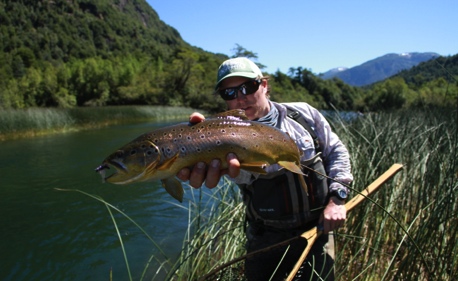 |
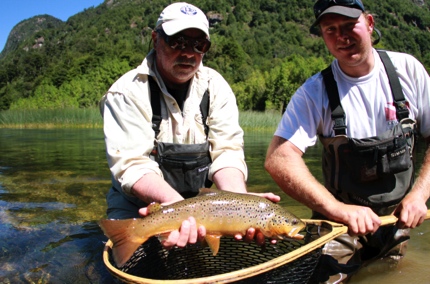 |
The Lagunas: Picacho River Marshes
These are very large deep marshes off the Picacho which we get to by boat and then walk in about 10-15 minutes. In times of rain the ground can be a bit spongy but the fishing is probably the best we have to offer and the fishing is done from boats we have stored there. We almost always use streamers there and sometimes there can be a bit if wind since the area is open and fot this reason we recommend using a 7 weight there.
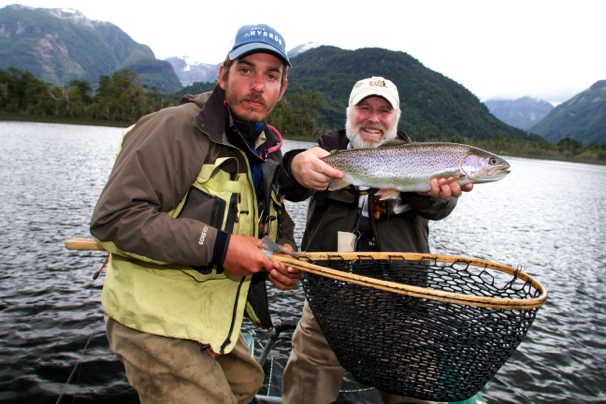
River Cobarde (Coward):
This is a small river with water very clear and you can wade it completely. This river is especially good for light tackle and has a great quantity of smell trout. However in some cases you can get a surprise with a much larger fish using small mayflies and caddis flies.
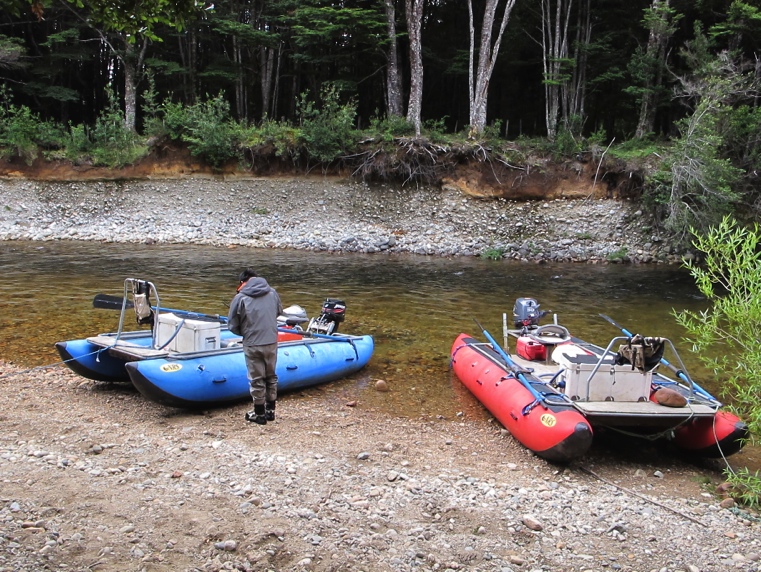
Recommended Equipment
- Rods # 5 & 7
- Floating line
- Sinking Line sinking tip 250 grains
- Sinking Line full sinking
- Leaders 0x-1x-2x-3x
- Tippet 0x-1x-2x-3x-4x
- Waders and Boots – NO FELT SOLES
- Fishing jacket breathable (GORE-TEX)
Climate:
The valley of the Picacho presents a temperate climate with rain all year round and no dry season although the period of heavy rain is during the Winter months of June to September. There is occasional but much lighter rain during the summer months. The temperatures can swing from 80 F during the day to 45-50 at night so it is advisable to bring clothing suitable for these different climates. The days can change rapidly as the weather comes in quickly from the Pacific with the months of highest temperatures are from mid December to the end of February.
Salmonide Species
The species in the watersheds we fish are Brown, Rainbow, and King Salmon and the official fishing season is from October 15 to end of April.
Flies Most Utilized:
Dry Flies:
Stimulator, Foam Dragonflies, Foam Damselflies, Caddis, Mayflies, Madame x, PMX, Elk Hair Caddis (9-16), Parachute Adams,
Terrestrials:
Chernobyl Ant, Fat Albert Larger (diferentes colores), Club Sandwich, Dave´s Hopper,
Nymphs:
Prince, Dragonflies, Damselflies, Caddis Pupa, Hare´s Ear, Pheasent Tail, Callibaetis ninfa, Zug Bug.
Streamers:
Yuk Bug (olive, grizzle, bead head pepperoni YB, black), Gray Special, woolly Bugers (negras, café, oliva, blanca, rojas), Clouser Minnows, Muddler Minnows, Egg Sucking Leach, Zonkers, Matuka, Mickey Finn
Season 2011-1012:
The past season was very productive in relation to the fishe caught per client. We had a large quantity of rainbow and brown trout with aboud 2-3 poinds being the average. There were also caught large King Salmon some in the 40=50 pound range.
The flies most used in the rivers of medium to large size were Wooly Buger type streamers (olive, black, white, and purple), Yuk Bugs, and different streamers with rubber legs with variations like Grey Special and Bead Head Peperoni Yuk Bug. In the area of dries all the terrestrials in foam were very good especially Fat Albert, Club Sandwich, Chernobyl Ant (in large sizes) and dragon fly (odonato) imitations like Foam Damsel, Foam Dragonflies gave excellent results as well.
In the lakes and lagunas the flies used were big streamers like Zonker Matuka, Mickey Fin, and Muddler Minnows. In the areas near fallen trees and reeds on hot days the foam dry flies gave very good results and facilitated the fishing of out clients because of the floating characteristics.
In the smaller rivers the best fishing was associated with small imitations of aquatic insects in their different states. The nymphs most productive were Prince, Hare’s Ear, Pheasant Tail, and Bead Head Caddis Pupa. In many cases the fishing was with droppers having 2 or 3 flies in the same leader. In the same way small dry flies like Elk Hair Caddis, and variations of Mayflies with hooks between 12-18 gave very good results.
Although from the middle of December to the end of February the temperature was higher than normal, the climate always maintained a very agreeable range with some weeks warm and other weeks cool with a little rain. This is why we recommend that all our guests bring a range of clothing so that they are prepared for the warm, cool, dry, and wet days
